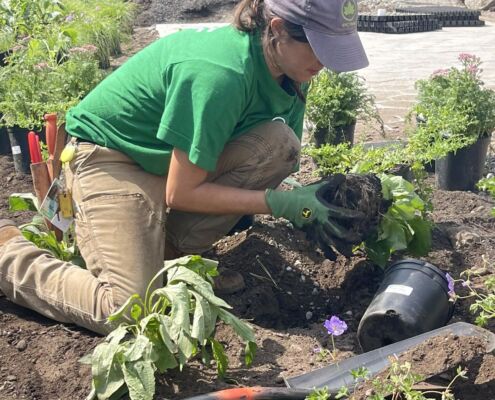Sustainable Landscapes in Seven Simple Steps
Discover easy, sustainable landscaping tips that help you create a beautiful, resilient yard while conserving resources and supporting a healthier environment.
Sustainable landscapes do more than turn heads. They cool the environment, improve air and water quality, support biodiversity, and bring communities together. Whether you’re starting from scratch or refreshing your yard, sustainable landscaping is a smart, earth-friendly approach that enhances the beauty and value of your home.
At Project EverGreen, we believe every homeowner has the power to create greener, healthier, and more inviting outdoor spaces. Here are some practical tips you can follow to design a landscape that’s as sustainable as it is stunning.
- Plant the Right Plant in the Right Place
One of the simplest ways to reduce resource use and maintenance is to choose plants suited to your region’s climate, soil, and sunlight levels. Native and climate-adapted plants typically require less water and fertilizer and are more resilient against pests and disease. Consider working with a local garden center or extension office to identify plant species that will thrive in your yard’s specific conditions.

- Build Healthy Soil
Soil is the foundation of any successful landscape. Enrich your soil with organic matter like compost or mulch to improve its structure, retain moisture, and promote root health. Avoid compacting the soil, and if possible, test it before planting to understand its nutrient makeup. Healthy soil means healthier plants and fewer inputs over time.
- Mulch to Your Advantage
Mulching around trees, shrubs, and garden beds helps retain soil moisture, regulate temperature, and suppress weeds all while adding nutrients back into the soil as it breaks down. Choose natural, biodegradable mulches like shredded bark, pine straw, or composted leaves, and avoid piling mulch against plant stems or tree trunks.
- Water Smarter, Not Harder
Overwatering is not only wasteful but can lead to plant stress and disease. Water early in the morning when evaporation rates are low and use drip irrigation or soaker hoses to deliver water directly to plant roots. Consider collecting rainwater in barrels to reuse for landscape irrigation. And always adjust your watering schedule based on seasonal rainfall and plant needs.
- Incorporate Pollinator-Friendly Plants
Pollinators like bees, butterflies, and hummingbirds are essential to a healthy ecosystem. Add color and life to your yard by including flowering plants that provide food and habitat for these beneficial species. Choose a variety of plants that bloom at different times throughout the growing season to provide consistent nourishment.
- Compost Yard and Garden Waste
Instead of bagging grass clippings, leaves, and garden trimmings for disposal, compost them to create nutrient-rich material you can reuse in your garden. Composting reduces landfill waste and helps close the loop on your landscape’s natural nutrient cycle.
- Maintain With the Future in Mind
Regular maintenance – pruning, mowing, fertilizing, and weeding – keeps your landscape looking its best. But doing it sustainably means using best practices: sharpen mower blades, calibrate spreaders, and monitor your landscape for early signs of plant stress. Keeping your tools and timing in check can make a big difference over time.
A sustainable landscape isn’t just about today it’s about creating a legacy of green spaces that contribute to the health of your family, your neighborhood, and our planet. At Project EverGreen, we’re committed to supporting homeowners and communities in making landscapes that are not only beautiful but built to last.
Together, we can grow a greener, healthier, cooler Earth – one yard at a time.



